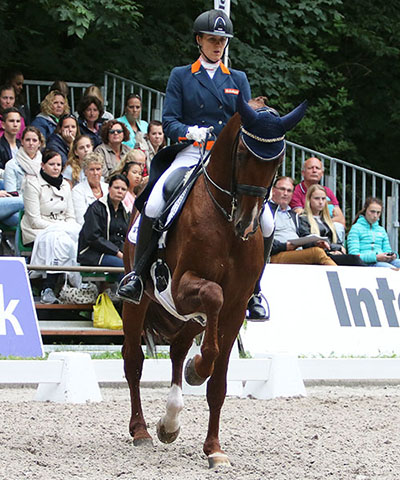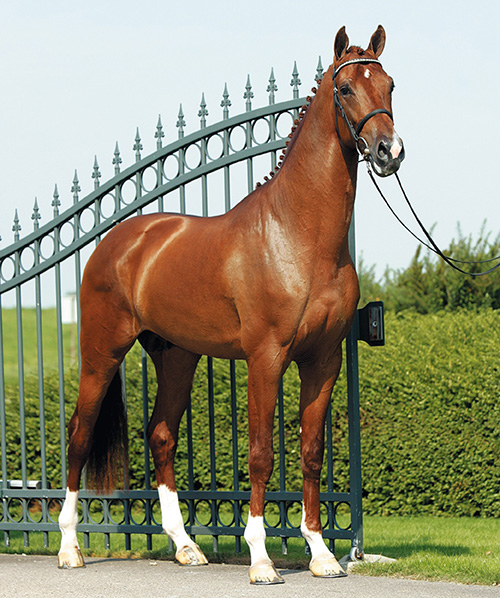
2002 1.70 cm Chestnut Breeder: Antoon Versantvoort
Vivaldi was the shooting star on the 2019 WBFSH rankings, coming in at number nine, up from 18th. The chestnut remains one of the hottest stallions on the scene in both Germany and Holland.
The Paul Schockemöhle Stallion Station is rightly proud of one of the headliners on their roster:
“2018 was once again a real festival for Vivaldi. Vivaldi produced the two-million-euro stallion market sensation in Verden, our premium stallion Vivino. Vanity Fair won the Herwart von der Decken Schau, the annual Hanoverian mare championship in Verden. And Vivaldi’s licensed son Veneziano/Daniel Bachmann Andersen/DEN won the Louisdor Prize for the best young Grand Prix horse in Frankfurt. He has produced a total of 35 licensed stallions. During his breeding career in the Netherlands, Vivaldi produced, amongst others, Cennin/Madeleine Witte-Vrees/NED, who came fifth in the World Cup, Desperado/Emmelie Scholtens/NED, who is successful at Grand-Prix level, Eye Catcher, double bronze medallist at the World Championships and victorious in Small Tour, Dancer, World Champion and Vitalis/Isabel Freese, Burg Cup winner. He also produced the Westphalian Reserve Champion Van Vivaldi, the Oldenburg Reserve Champion Versace (originally called Viva Vechta), the 2nd Oldenburg Reserve Champion Veneziano and the Hanoverian premium stallion Livaldon. Felix won double gold at the Pavo Cup in 2015 and 2016 in the Netherlands.”
Vivaldi was also in evidence at the most recent World Young Dressage horse championships in Ermelo, siring one representative, while his son, Vitalis was responsible for four. Vitalis, Vivaldi’s first licensed stallion, has had quite a dramatic career. Bred by Toon de Crom and W. Verbakel, he was presented at the Westfalien stallion licensing in 2009, where he was crowned Reserve Champion. Leased to the Westfalien State Stud, he stood for three years. During that time he was presented at the KWPN stallion licensing, but was not accepted.
Vitalis competed in the 2012 World Young Horse Championships to finish sixth in the consolation finals. He was sold to the American based, Danish rider, Charlotte Jorst in September 2012. Ms Jorst and Vitalis competed at the 2013 World Young Horse champs in the six year old class to finish 13th. He went on to win the US Young Horse Championships that year. In 2014, the pair competed in Small Tour classes and were 11th in the Inter I Freestyle at the US Dressage Champs. Vitalis disappeared from competition in 2015 before being sold in September of that year to Paul Schockemöhle and Lone Boegh Henriksen and brought home to Germany.
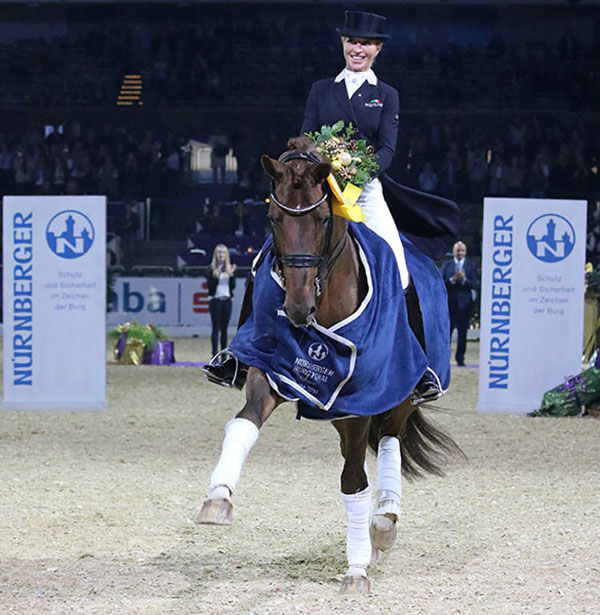
Ridden by Schockemöhle stable rider, Isabel Freese, Vitalis won the 2016 Nürnberger Burg-Pokal, and since then seems to have concentrated on his breeding duties
– with success.
story continues below the advertisement
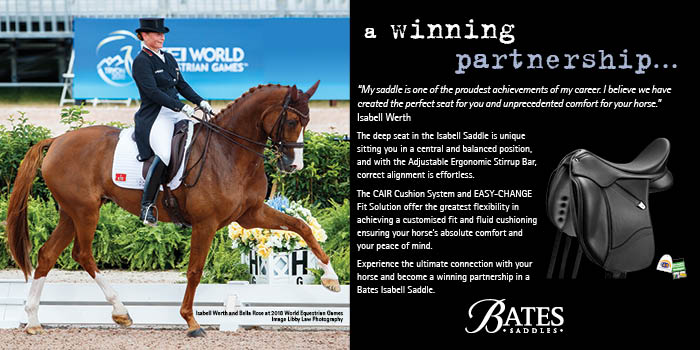
Vivaldi was also the buzz stallion at the 2018 Hanoverian licensing, mainly through his son, Vitalis. Hanvoerian breeding expert, Ludwig Christmann thought it was Vivaldi rather than Vitalis that attracted the breeders.

“It is not only Vitalis, it is Vivaldi in general. When you look at the sons and grandsons of Vivaldi, you can see his qualities.”
So you think it is Vivaldi more than Vitalis, certainly in Holland they think Vivaldi is the most exciting younger stallion…
“I remember when he first started as a stallion there was a question mark behind him, it was felt that Vivaldi would not be a Grand Prix producer but now we see offspring of Vivaldi competing in Grand Prix. At our licensing, Vivaldi was the most influential stallion, I think he had 16 stallions with his blood at the licensing. The riders like the mix of traditional Hanoverian blood, particularly from the ‘D’ line, and some Dutch blood.”
Interesting then that Vivaldi’s two most successful Grand Prix horses, Cennin, and the emerging Blue Hors Venezio are both out of Donnerhall mares.
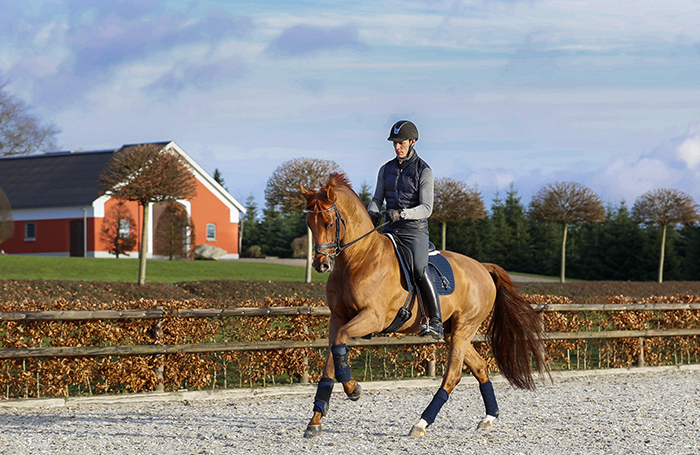
Venezio and Daniel Bachmann – Photo: Jacques Toffi
Story continues below the advertisement
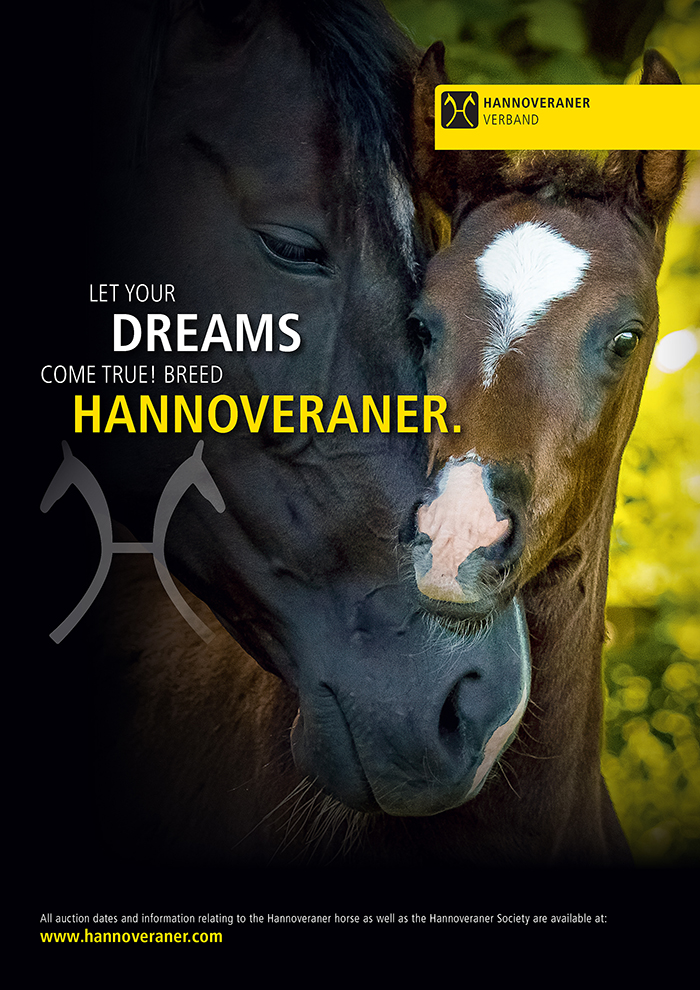
Vivaldi was Reserve Champion of his stallion performance test in the Netherlands and won the Pavo Cup for five-year-old dressage horses in 2007 In 2008 and 2009, ridden by Hans Peter Minderhoud, he won the KNHS/KWPN stallion competition, where he was awarded 10.0 for his trot. He was then internationally successful up to Prix St. Georges. In 2013, he won the VHO trophy at the KWPN licensing. He was another of the modern stallions that made it to Prix St Georges, but then failed to make the leap to Grand Prix.
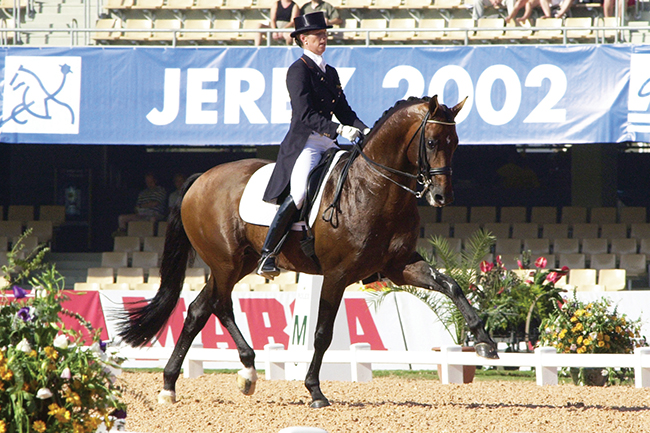
Krack C and Anky van Grunsven at the Jerez WEG
Vivaldi’s breeding is a history of dressage breeding in the Netherlands. His sire Krack C was eighth at the 2002 WEG with Anky van Grunsven. Krack C is by Flemmingh, one of the first dressage specialist sires in Holland (even if stallion keeper, Wiepke van der Lageweg thought he was buying a jumping sire) while Krack C’s dam, Gicara II brings a heady dose of ‘blood’ to the equation. She is by Beaujolais, who was by Lucky Boy xx, out of Venice by Lorenz (by Ladykiller xx) out of Maga by Willow Cratic xx. That’s 75% Thoroughbred.
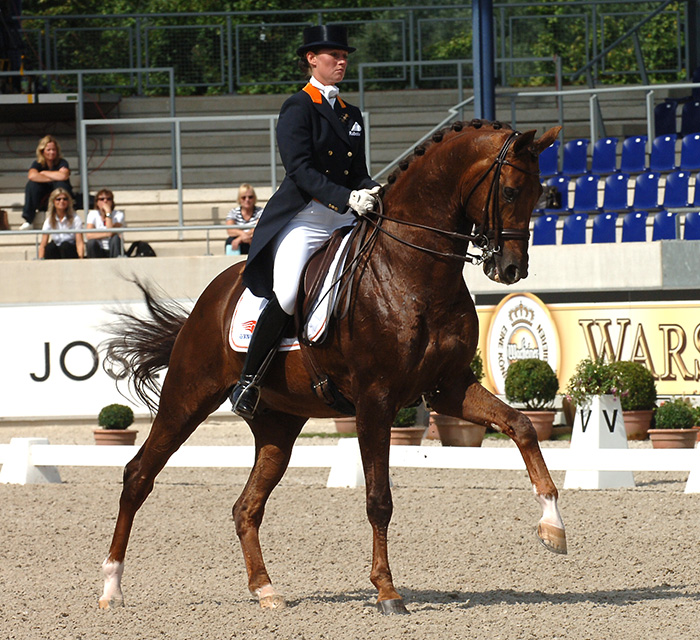
Jazz, a producer and a competitor at the highest level
Vivaldi’s dam is by the most famous of Dutch dressage stallions, Jazz, who headed the WBFSH stallion standings on numerous occasions, and she comes from the famous Utopia line of mares, although the line is more famous for producing great jumpers like Arko III and Darco, than dressage horses.
Caroline Ironside interviewed the breeder, Antoon Versantvoort about his Utopia line, on the website, HorseBreedersMagazine.
Apparently, Mr Versantvoort describes himself as a “hobby breeder”, but a hobby breeder with a history.
“Horse breeding has already been in the family several generations,” he told Ms Ironside, “At the time, my grandfather had already bred an Approved stallion. With this stallion they took him out for one year through the country to cover mares. Later came the transition from work horses to sport horses, and at an early stage my father bought a luxurious and modern mare which he has bred some foals with. I acquired one of those foals from him to start my own breeding.”
“At that time, we went through all the inspections to see how we would do, and we actively participated with the horses we had. After several years, it became clear to me that the mare line is very important in breeding. When my mare died unexpectedly, I then decided to find a mare from a known strain.”
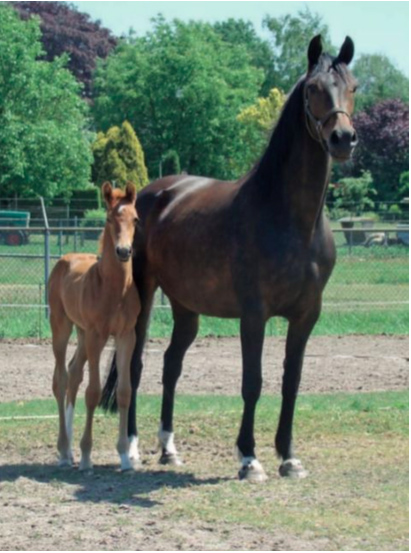
Renate-Utopia
“At the time, I knew someone who successfully bred with the Utopia dynasty, who had a filly for sale out of the Jazz mare Darla-Utopia (Ulft). This filly was Renate-Utopia and I bought her in 1998 to be my future breeding mare. Renate-Utopia comes from the famous Nomana dynasty, mare line 2, breeding family 8.”
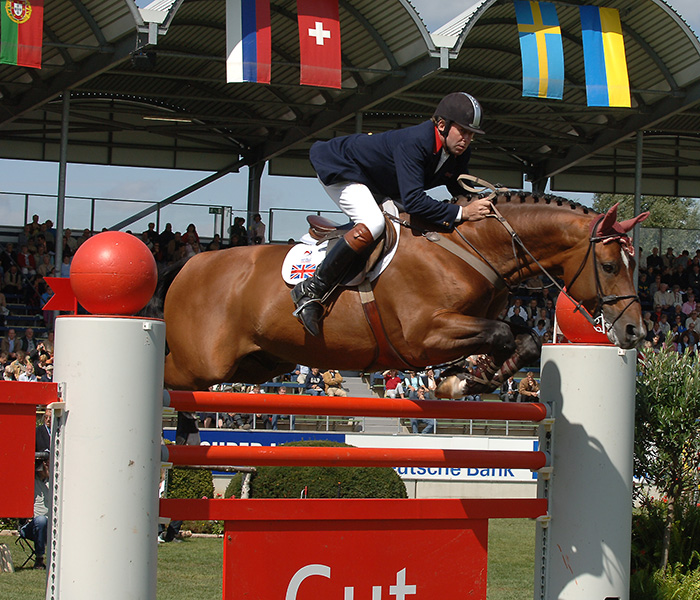
Nick Skelton and Arko, from the Utopia mare line, by Argentinus
The Utopia-line has produced both dressage and jumping horses, including Nick Skelton’s Arko III, the KWPN stallions, Premier and Radar, and international jumpers, Loretta, It’s the Business, Now or Never, Darco and Opium. The original ‘Utopia’ mare is Ellen-Utopia, by the Trotter stallion Kan Pom B, out of the Gelderlander mare, Gerda. Her daughter, Hellen-Utopia was by the L’Invasion son, Boris.
Mr Versantvoort was well pleased with his choice:
“Renate-Utopia herself easily became Ster as a 3-year-old. Unfortunately there was no Central Examination (Keuring) to go to that year because the Foot & Mouth Epidemic prevailed. We had her under saddle for a few months, but because of a busy private life, we decide to have her only as a breeding mare. This has certainly paid off and she was already awarded Preferent on just her first three offspring, and as an 11-year-old she received the title Prestatie.”
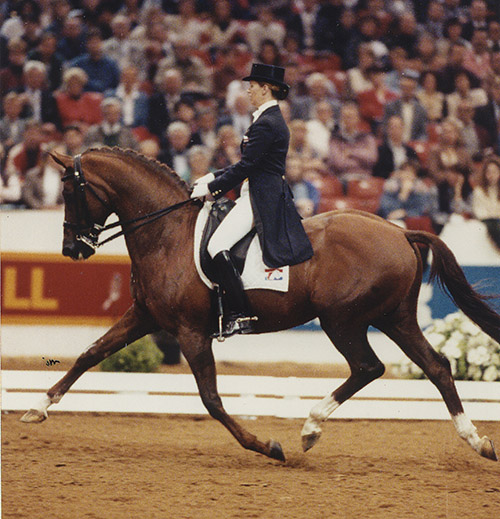
Cocktail and Anky…
Vivaldi’s grand-sire, Cocktail was a Grand Prix dressage winner with Anky van Grunsvan. His sire Purioso was an influential sire of dressage and jumping horses in the Netherlands. He is by Furioso II, further evidence that the French stallion imported to Oldenburg by Georg Vorwerk, is the most influential sire in the performance horse world today.
Arie Harmoen was for many years the head of the KWPN stallion committee, he remembers Vivaldi well when he appeared at the stallion show:
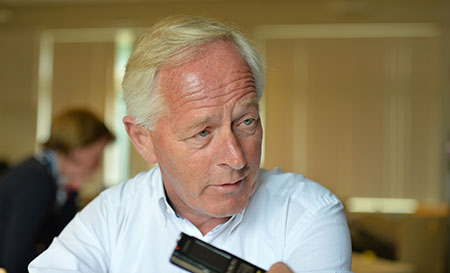
“At the stallion show of 2005, Vivaldi was in the third place. Johnson was the first. Vivaldi’s condition was not so good, he looked very young, but he was also a very nice mover, and very nice temperament. When he was presented free moving, and in free walk, he did a very good job, but he was still a young horse, too young. He looked like a two year old… Some people said, why was he third? There was not a lot of muscling, not a lot of conditioning, but he was a good mover that’s why he was third.”
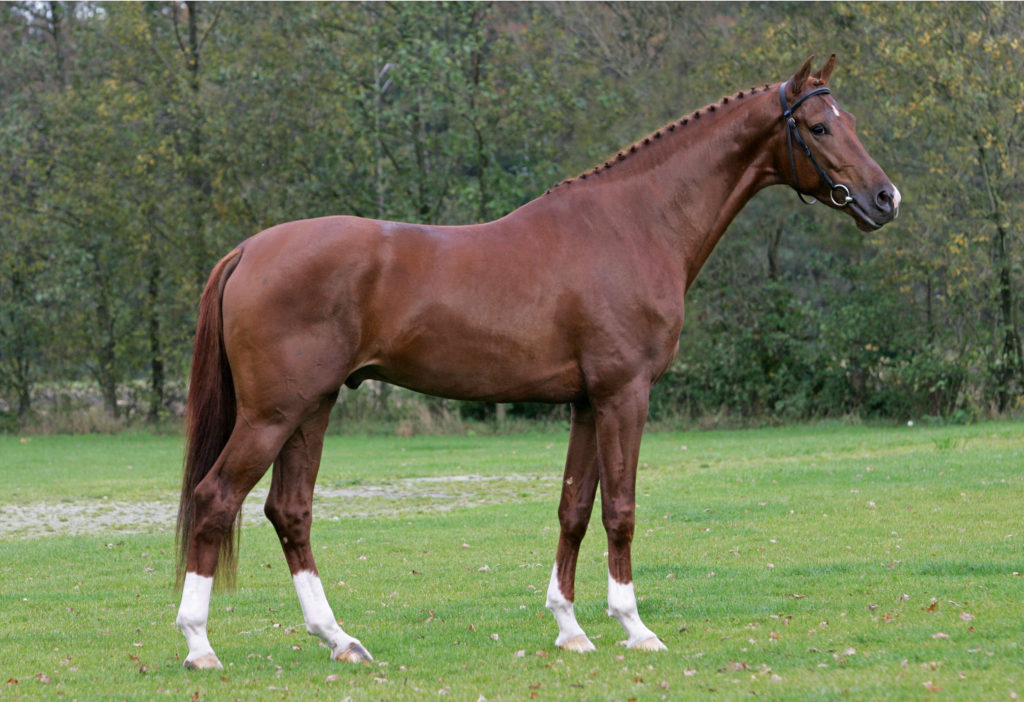
Vivaldi
The mother line?
“It was normal. Good enough, good functional horses, but they had not a lot of chances – it depends, some horses have more chances, some breeders bring them to riders and let them go Grand Prix. Vivaldi’s mother line was average, good stallions, but not a lot of results in the sport.”
I find it interesting that Vivaldi never made it to Grand Prix, he got no further than small tour, but he is breeding Grand Prix…
“That is the interesting side of breeding. You have Grand Prix horses that never breed Grand Prix offspring. Damon Hill for example, he was a fantastic Grand Prix horse but you see not a lot of offspring in Grand Prix. Vivaldi is a little bit like Sandro Hit, although he went further than Sandro Hit – to Prix St Georges. I think the problem with Vivaldi was that as a young horse he had trouble with his stomach, he needed a little bit special food. He was easy to handle in the arena, but sometimes in the stable he was a little bit nervous, I think that was part of the problem.”
Hans Peter Minderhoud who rode Vivaldi in his competition career, thinks the failure to go on was related to trying to combine a competition and breeding career:
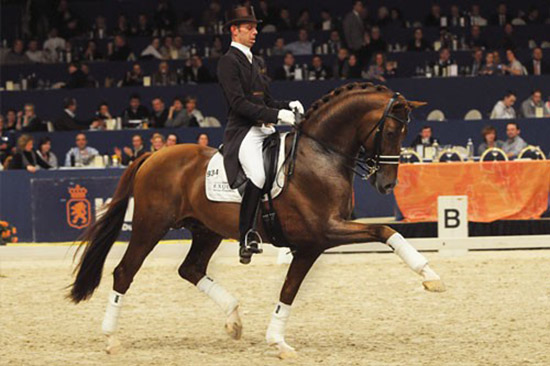
Hans Peter and Vivaldi…
“It’s a problem with stallions that were successful as young horses, they have been breeding like crazy every year, frozen semen in the winter, fresh semen in the summer, and with some you just have to make a decision, if the value is higher as a breeding stallion, then keep just him as a stallion because I cannot do both with him.”
Story continues below the advertisement
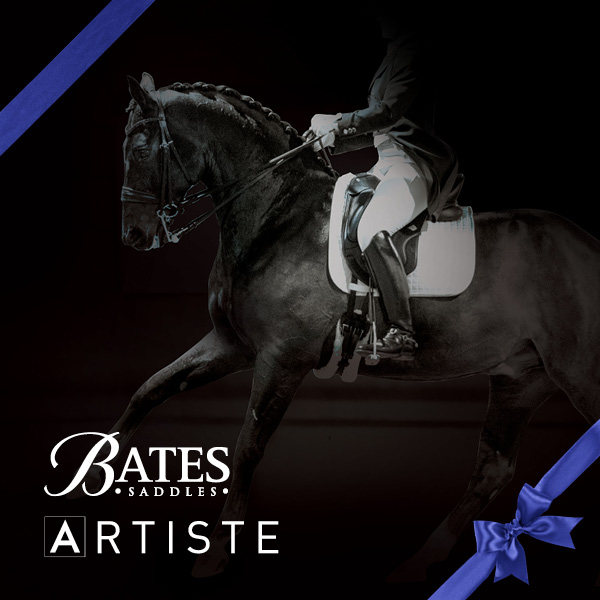
Floor Dröge works for the KWPN, her job is inspecting the mares, but she had a rare opportunity to evaluate Vivaldi:
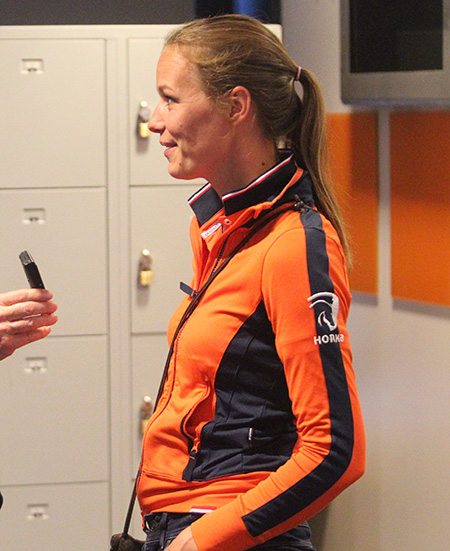
“I rode Vivaldi in the performance test! He was amazing. He had the best head and rideability that you could wish for, and you see that with his offspring. You really see it, really nice characters, really able and willing to do it.”
Yet he never made the jump from Small Tour to Big Tour…
“No, but he did everything at home. That’s the question, does he need to do the Grand Prix? Vivaldi didn’t but if you look at the horses he is producing they are great, so I don’t mind that he didn’t do the Grand Prix himself. If you’ve got the mare with the hind leg and the things you want, use Vivaldi.”
Did he feel special from the first time you sat in the saddle?
“His rideability was very nice, as a three-year-old he went on a long rein outside, just enjoying himself, and you also see that character with his offspring.”
What other young stallions are interesting at the moment?
“A lot of them.”
Which are most interesting to you?
“It depends on the mare for sure, it totally depends on the mare. Take Vivaldi, I fancy Vivaldi but until this year, I didn’t have a mare that suited him, so I never used him. Now I have a Ferro mare, Vivaldi / Ferro, it’s a really good combination. Even with a great stallion, it needs to suit him.”
“I had a very small, very elegant horse, and she didn’t fit him, I needed something else for that mare. You have to look at what are the good points in the conformation but also the movement and the rideability of the mare, what do I want to preserve? What do I want to change?”
The mare you bred to him, what were the characteristics that said to you, this mare is good to go to Vivaldi?
“She’s a bit sharp, she’s always on, always ready to go. So cool her down… what do the judges want to see? They want to see a test that is so fluent, that it looks like it doesn’t take any effort from the rider, from the horse. You want them to go, and you want them to relax as well and that’s big job when they are five, six, seven-year-olds, and they have to go into a big arena like Ermelo, wow! And if they are not active enough, if the power is not there, everyone goes, oh he’s not special, and when they are too active and too much power, they go, oh he is tense and he is forced. It is a real balance. You need to search for it to make it for you, the rider, as easy as you can.”
In 2009 Vivaldi was the second most popular breeding stallion in The Netherlands with 285 mares. In 2011 Vivaldi only covered 33 mares, which I guess shows just how important success in the sport can be for a Dutch stallion. These days the KWPN declines to release the figures on how many mares each stallion covers – the last figures I can find are for foals born in 2018, when the Vivaldi son, Dream Boy (Ferro), a Grand Prix star with Hans Peter Minderhoud was fourth with 138 mares, but Vivaldi does not appear in the top five…
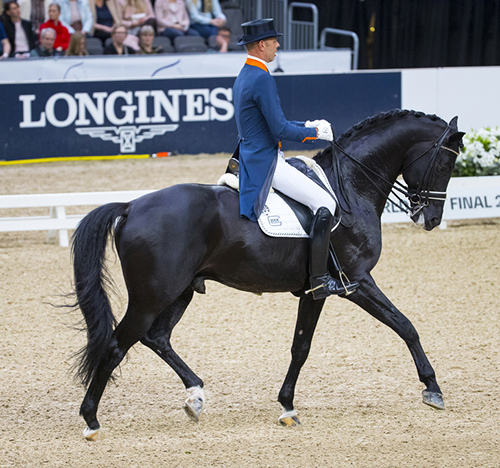
Hans Peter and Dream Boy
Vivaldi’s ninth place on the WBFSH sires rankings comes from eight international competitors, the two most successful being Dream Boy and Desperado (Havidoff).
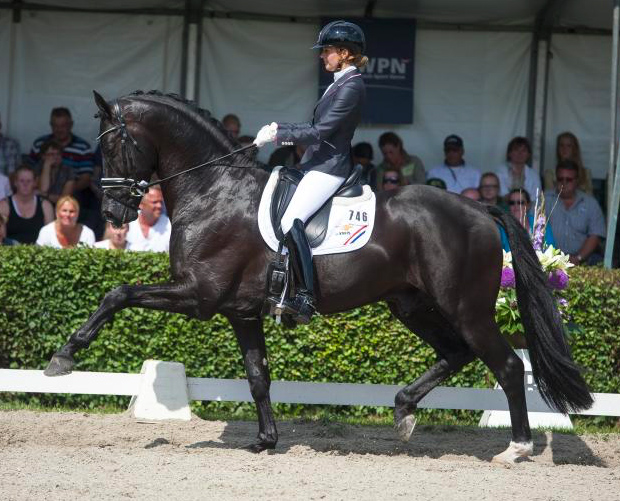
Desperado
Vivaldi was second on the 2012/13 KWPN breeding values on the 80/89 rankings with a breeding value of 158 (82%)
Vivaldi appeared in 6th place on the 2014 KWPN dressage stallion breeding values for stallions with a reliability of 80% to 89%, with a value of 147 (87%).
By 2014, he had produced 612 KWPN progeny over the age of four, of whom 115 had been registered for competition – that’s 19.28%
On the 2015/16 values, his reliability has increased to 92% so he has moved onto the over 90 table, but his breeding value has dropped to 146 putting him into 12th place. His participation has however improved – now he has 889 progeny over the age of 4, with 247 competitors, that is 27.784%.
Vivaldi’s dressage value has increased to 159 on the 2016/17 KWPN standings, which puts him in 4th place on the ranking of stallions with a reliability of over 90%. He has a conformation score of 114, and 116 for free movement. He has produced 930 progeny over 4, with 281 competitors (30.21%).
On the latest, 2019 KWPN rankings Vivaldi with a dressage value of 171 is in fourth spot, behind Jazz (189), Olivi (182) and Painted Black (186).
Vivaldi’s son, Cennin (out of a Donnerhall mare), has been successful with Madeleine Witte-Vrees since he commenced his Grand Prix career in March 2016. The pair were 6th in the Grand Prix at the World Cup final in Omaha, and 5th in the Freestyle.
In a surprise move in January 2017, the KWPN licensed two sons of Vivaldi, Vitalis and Cennin, after previously rejecting them.
Cennin and Madeleine Witte-Vrees (photo Kenneth Braddick)
The buzz around Vivaldi right now is very positive. Former long time head of the KWPN stallion committee, Arie Hamoen remarked to me at the 2017 Young Horse champs when I asked him who was the heir to Jazz:
“Vivaldi is coming up. The rideability is good and the first sons are knocking on the door of Grand Prix. The only problem for Vivaldi is the quality of his semen. Vivaldi’s sons are also knocking, Dream Boy for example. Vivaldi is putting the next step in the line of Jazz.”
Vivaldi progeny gallery follows, then a video clip of the stallion himself
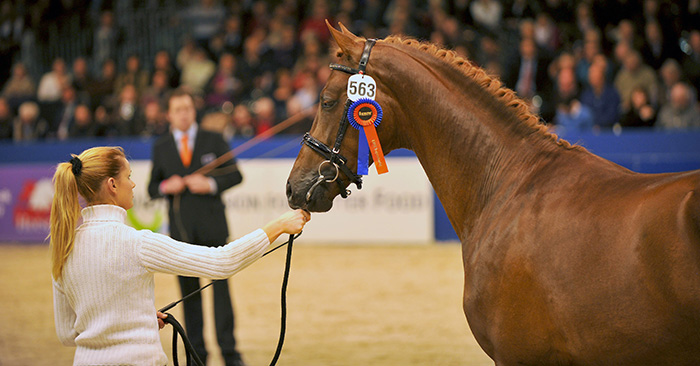
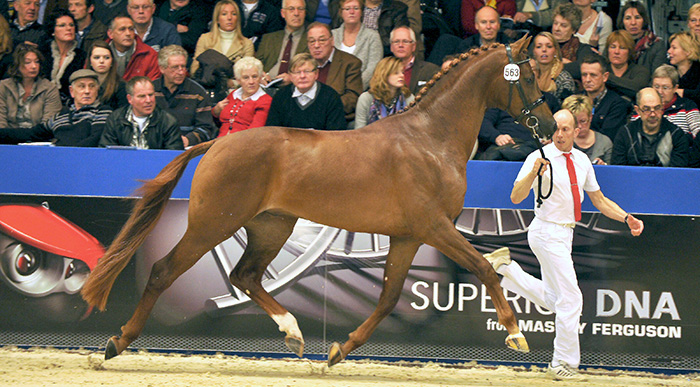
This colt was discussed at the KWPN Study Group in 2012, here’s what Johan Hamminga said about him:
“This colt is by Vivaldi, out of a Havidoff/Roemer mare. I like his neck position, he has good distance behind his cheek, he can bend there. The legs are good, and in proportion to his body – the only thing is that he could have a little more condition.
This stallion comes from a very good mare line that has produced a lot of dressage horses, including Hans Peter Mindenhoud’s Nadine. The most important thing with this horse is that he is calm. When there is a noise, he stays calm, he can regulate his temperament. I love his eye…”
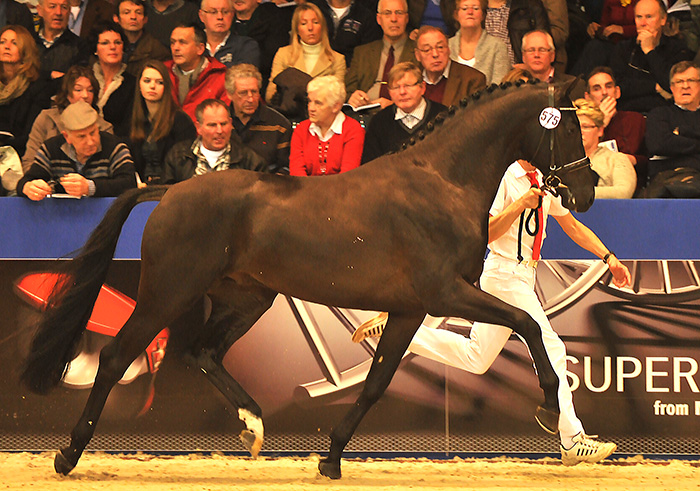
This is a Vivaldi/Balzflug
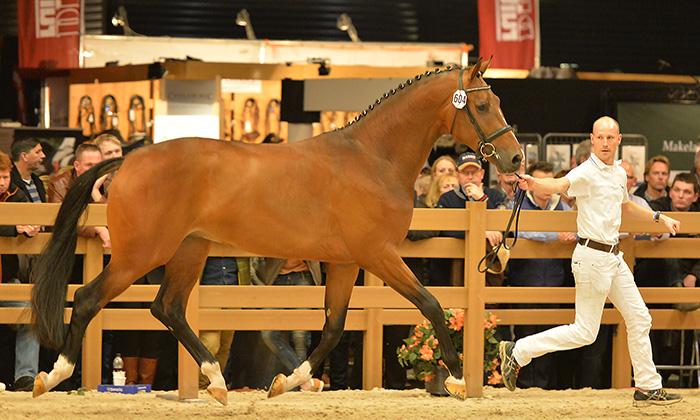
This colt is out of a mare by Dr Reiner Klimke’s Biotop
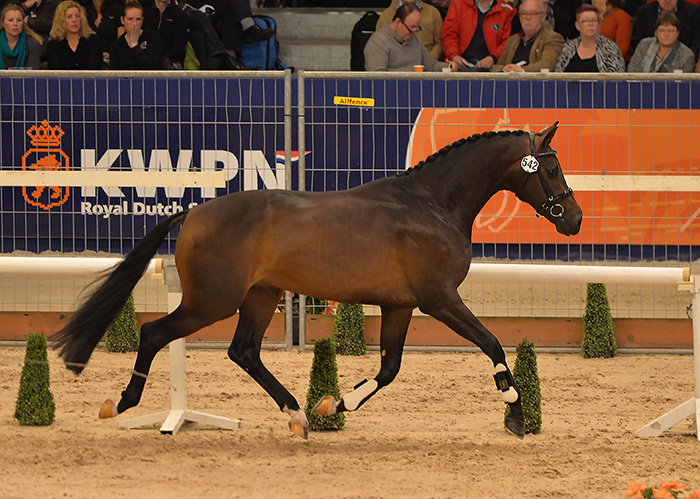
Vivaldi/Donnerhall, two pics of this lovely colt
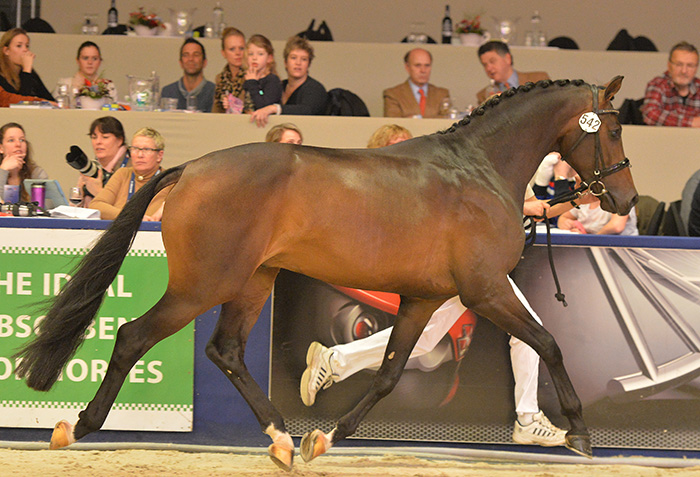

Both Vivaldi, and his son Vitalis are available in Australia this season from International Horse Breeders: Contact www.ihb.com.au
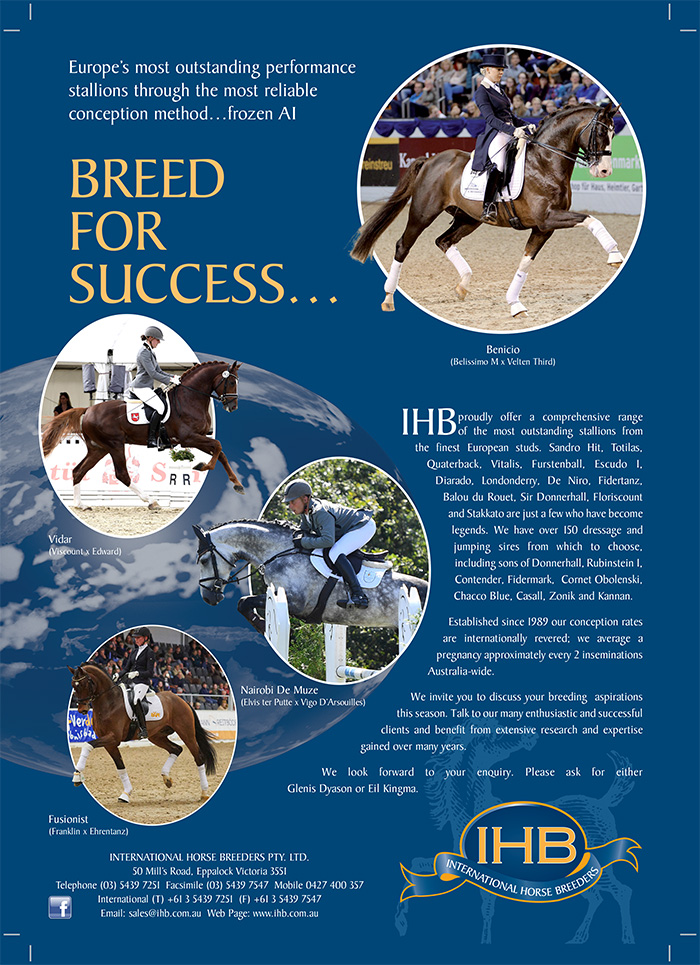
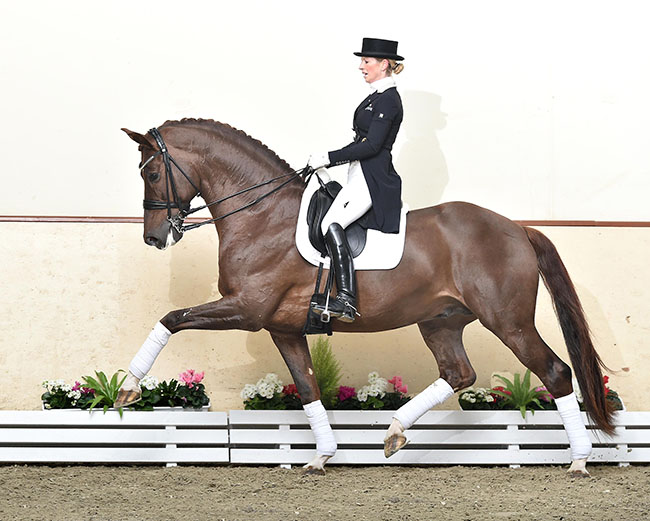 Vitalis
Vitalis

